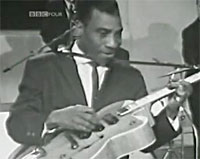One of the first questions I get from someone who wants to learn blues guitar is, ‘what are the blues guitar scales I should learn?’ And the answer is easy… all of them.
I know that seems kind of flippant, and no I don’t really mean it, but in the long run, you’ll use every note on your guitar to play the blues. There is no specific scale as such because as you start to play more sophisticated blues, you’ll use so many passing notes that you really go beyond any particular blues scale. The passing notes may not be the part of the framework of the song but they sure add a lot of interest and sophistication to the lead you are playing.

T-Bone Walker
Now of course, in the beginning you don’t need to know every note. And there are some nice simple scales that work well in the blues. Dang if B.B. King, T-Bone Walker or Albert King can’t play a great blues lead using just 3 or 4 notes. And there is a simple 5 note scale called the pentatonic scale that is really the core notes of all blues guitar scales. More about that in a second.
So as beginner, start at the beginning. Learn these simple scales and learn to build blues leads from these simple scales. You can still sound great when you go to a blues jam or play with others.
What About Blue Notes
Of course, the blues sound comes from certain notes that just about all blues guitarists use over and over. The “blue notes” that give you that blues sound are the flattened third, flattened fifth, and flattened seventh scale degrees of a key. If that doesn’t make sense to you yet then maybe a little music theory is in order. Check out this page for some great resources to get started with some theory.
But actually, on guitar, these blue notes are often achieved by stretching or bending the guitar strings up to get that blue note. The guitar is one of those instruments (along with many horns) that can bend a note up to get that flattened third or fifth note. Try doing that with a piano.
And yes, there is something about those notes that just grab you. They seem full of emotion and maybe even pain. When you hear a great guitarist like B.B. King or Joe Bonamassa hit those notes, you know you are hearing the blues. And if a guitarist doesn’t move you then those notes are not being played correctly.

Blue Note Scale – Blue Notes In Blue
And the fact is, if those notes are not being used then maybe your are not listening to the blues.
Do You Need To Know Theory?
Of course, to a blues guitarist who doesn’t know anything about theory, they couldn’t care less what “degree of the scale” the blue notes are. They picked up the guitar and just started finding those notes, and started using them because they sounded good to their ear. Maybe they learned it from another guitarist who just showed them the fingering and they went on from there.
You could argue that the early blues guitarists like Robert Johnson, Skip James, and Charley Patton, didn’t know music theory. They just learned from each other and learned to feel what worked and what doesn’t. the fact is, they were the ones that created it… so there was not right or wrong.
You could argue that that is what you should do as well. And you might be right. But why take the time when there are several short cuts that will get you there much more quickly. With today’s videos and online instruction, you can learn from others very quickly.
In fact, here’s a video I did that will get you up to speed with pentatonic scales.
Pentonic Blues Guitar Scales
And once you get these scales down, the next best step is to go listen to all the great players. Listen to B.B. King, Albert King, T-Bone Walker, and the real innovators of the blues. These are the ones that created the music and the blues guitarist that Stevie Ray Vaughan, Joe Bonamassa, and Eric Clapton all learned from.
And if you are ready for some great online lessons, I highly recommend TrueFire.com as a great place to go. I use it all the time.


